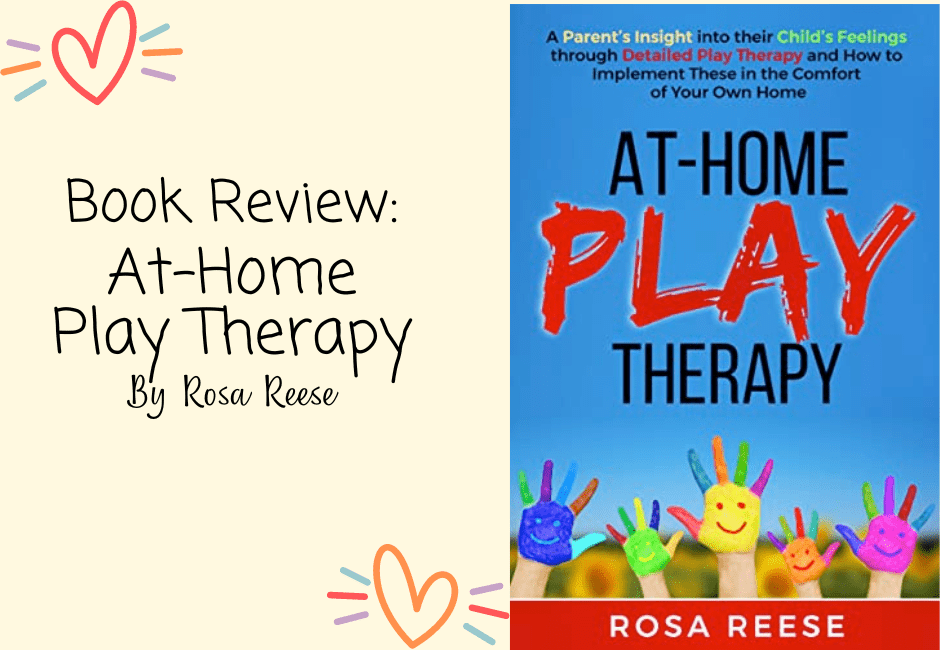Have you ever heard of play therapy? Did you know it can be done at home? Play Therapy is something I learned about in graduate school and have continued to be interested in. I am so excited about Rosa Reese’s book, At-Home Play Therapy: A Parent’s Insight Into Their Child’s Feelings Through Detailed Play Therapy and How To Implement These In The Comfort Of Your Own Home.
Note: As an Amazon Affiliate I earn from qualifying purchases made through affiliate links, at no extra cost to you. Read my full disclosure for more information.
What is so Important about Play?
Did you know that there is more to kids playing than just…playing? It goes so much deeper than that! Play is how children learn and develop skills in every aspect from cognitive skills, physical skills, and even emotional development! Children learn these things through play without us even needing to direct it, which is pretty cool.
In grad school I learned that it’s great to let kids play on their own without directing their play as they learn more that way. I have put this into practice with all 3 of my boys. Sure, I still will sit and play with them but I ensure they have plenty of time to play on their own or with each other without my involvement as well. (I’m still nearby in case they need me of course!)
There are also times when it’s important to structure play somewhat to enhance their learning as well as help them discover new things and how they work.
What is Play Therapy?
If there is a child who is having some difficulty and a therapist becomes involved, do you think that they’d sit and talk with a therapist the way an adult would? No. Depending on their age, they’d likely just sit there, silent, and not want to answer questions. Talk therapy typically doesn’t work with children when they’re young as they haven’t gotten to the development level of talking out situations and expressing their feelings constructively.
That’s where play therapy comes in.
As Ms. Reese explains in her book, “Play allows children to express emotions that may not be acceptable in other situations.” Further, “When your child experiences a traumatic event, he naturally learns to make sense of it through play.”
Therefore, using play therapy, instead of talk therapy, with children is very helpful.
Throughout this book, Ms. Reese helps parents better understand their children through specific instructions that parents can implement at home. She helps parents work with their kids especially in the sense of learning how to deal with one’s emotions which, let’s be honest, is even difficult for adults to do at times.
See below for more about what play therapy entails.
Table of Contents
This book goes from basic information of what is play therapy and how to keep your goals in mind when doing play therapy with your child, to specific play therapy activities for various ages. Below I’ll share the detailed Table of Contents that shows just how much great value this book has within it. As you can see, the ages in which specific play therapy activities are described are from age 0-12, with every few years broken down into separate sections.
This is clearly a book that you can refer back to for years and years.
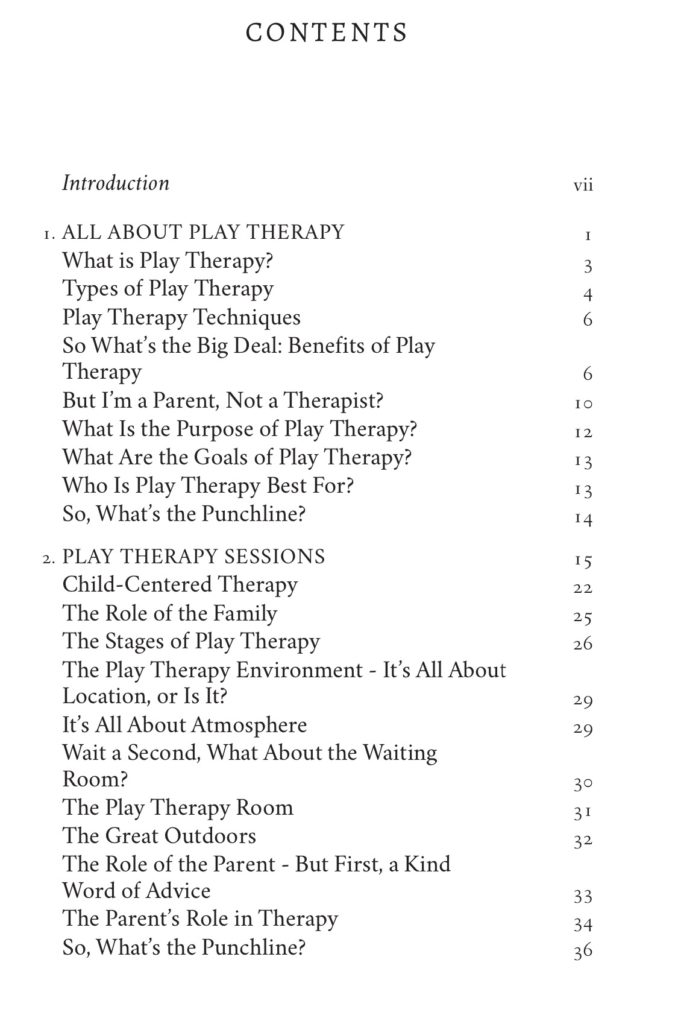
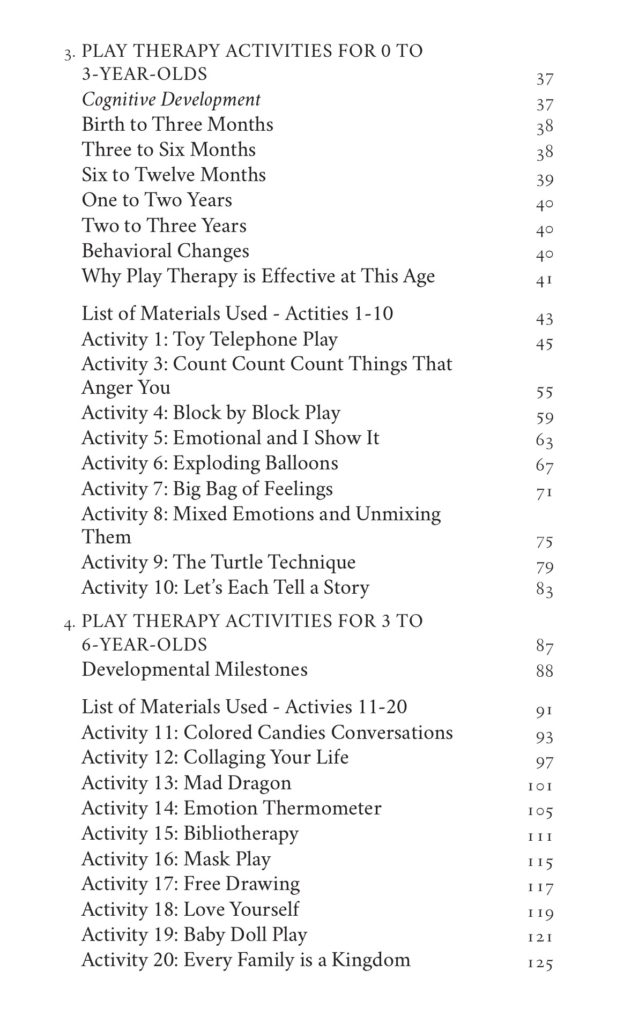
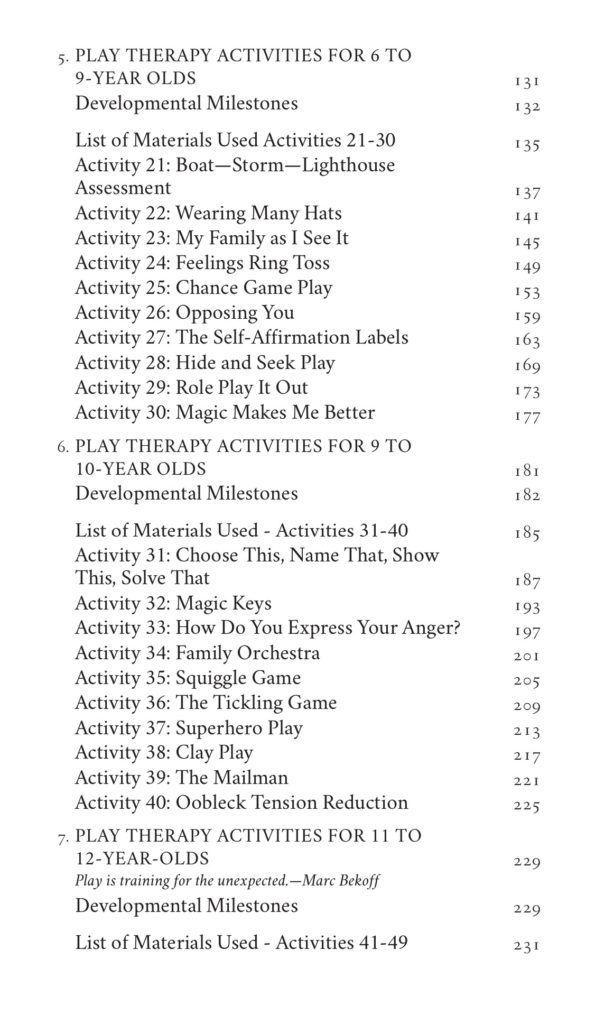
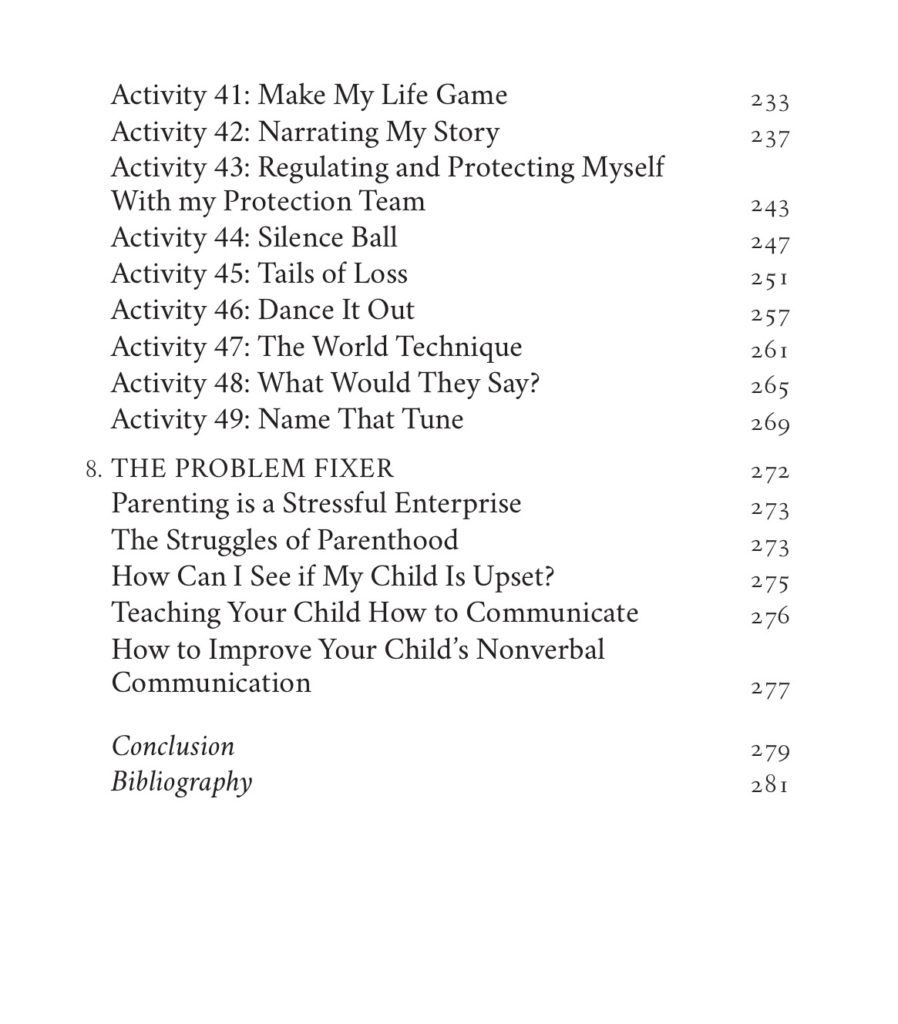
A Little Aside about My Experience with Play Therapy
As a graduate student studying to become a school psychologist, I had a play therapy course plus a portion of the course that was a ‘lab’ portion where we actually got to put our new knowledge of play therapy into action while working with kids in the community. It was quite the amazing experience. I had always been used to traditional cognitive behavioral therapy (CBT) better known as goal-oriented talk therapy. Play therapy was a whole new world to me and honestly I was a little skeptical that it’d work.
I shouldn’t have been and I’m glad I gave it a chance.
It was really neat to see how just being present in a space with a child while they played and asking them simple questions could tell so much about the child and their homelife. The particular child I was working with wasn’t particularly troubled and in ‘need’ of play therapy, rather, his parents were willing to let a couple graduate students practice on this little guy to further their education.
Even better, all of our sessions were recorded, with the parent’s consent of course, so we were able to look back and see things that we may have missed in the moment but stuck out later as ‘ah-ha’ moments and turning points in therapy.
We found that having kids play with dolls in a dollhouse ended up revealing a lot about their homelives. They would act out how they saw their parents act towards each other and toward them, without really realizing what they were doing. They just saw it as playing. Sometimes they’d even act these things out with animals or inanimate objects.
As a school psychologist, most of my job was focused on assessing students for special education services, but once in a while I was able to counsel a student. This was mainly in my first job when I had the time and energy to push for such a thing.
I remember there was one boy in particular who was in middle school and having a rough time. I figured he wouldn’t just sit and talk with me openly so I got some puzzles from the dollar store and a couple easy games like Connect Four that didn’t take a lot of concentration. This way we could chat while doing something which took the pressure off of both of us. It worked really well. He ended up opening up to me and we talked through what was going on his life more than we would have had we just been face to face. While focusing partially on a puzzle or game, and not looking directly at each other, he was able to let his guard down and talk to me like he probably would a friend.
Chapter 1: All About Play Therapy
The chapter opens with a story of a little girl who had endured some trauma and was in play therapy. The story details how the little girl expressed her feelings during play therapy while fixing up a disheveled teddy bear who she saw herself in as she felt she had a broken heart. The play therapist hadn’t directed her to this broken toy, rather she sought it out as it reminded her of herself and proceeded to fix up the bear throughout subsequent sessions.
Sometimes a play therapist, or parent, will need to provide some guidance to children during play therapy, whereas other times they will lead their own way through their trauma or issues.
Play Therapy is a child-led form of therapy for children experiencing emotional, social, or psychological issues. Play has the same effect on children as counseling has on adults.
Rosa Reese, Page 3 of At-Home Play therapy
With play therapy, children are able to express themselves through play much like adults can express ourselves with words. Children don’t typically develop that ability until they are older. Children are able to work through unresolved emotions through play within a safe environment.
Though this book is aimed toward parents, Reese provides insight as to how trained play therapists conduct play therapy and how, which is very helpful for parents hoping to use the same techniques with their own children.
Therapists reflect on children’s emotions to help them identify and name their feelings, build positive relationships with them, encourage them to open up, let them feel understood, and help them to become more self-aware.
Rosa Reese, Page 3-4
Throughout this chapter, Reese delves into the different types of play therapy including directive and non-directive, providing real life examples of each. Various play therapy techniques are touched on as well as the benefits of play therapy including the conditions it may help with.
Reese also discusses that though the reader of this book is typically a parent and not a therapist, it doesn’t mean that you aren’t able to use play therapy with your child. You actually have quite the advantage, you know your child best! The most important thing is creating a safe environment in which your child feels free to express their thoughts and feelings as well as acting them out through play.
It’s important to develop a good relationship with your child in this situation especially. Even if something happened at another time that caused a rift between you and your child and that topic happens to come up during play therapy, it doesn’t mean you should ‘switch to defense’ and start talking about why you did what you did. It’s important to stay in the current moment and let your child work through their feelings around the event. By using non-directive play you’re allowing your child much needed space.
The purpose and goals of play therapy are discussed as well as who play therapy is best for. As Reese notes, play therapy is usually used for children ages 3-12 but can be used for teenagers and adults as well.
This reminds me of a scene from my favorite TV show, The Office, where Toby who works in HR is tasked with counseling Michael, the boss who happens to greatly dislike Toby. Things aren’t going well until Toby suggests they just play a game and run out the clock. Suddenly Michael starts opening up until Toby asks one too many questions and Michael gets wise to his ways. It was great while it lasted though! Toby at one point before Michael caught on says “I’m doing it!” into the camera when Michael is out of view. I remember feeling that way when play therapy would work with a student as well. It was so neat!
TV shows aside, play therapy can be very helpful and done by anyone, even you, with enough knowledge of how to proceed.
Chapter 2: Play Therapy Sessions
This chapter starts with a real life story of play therapy and then beaks down a typical play therapy session. Just like anything else in life, you’re not going to see results right away and if you push it, it won’t happen.
It’s important to take into account the age of the child who will be participating in the play therapy session. Though Reese states that a typical play therapy session lasts about 45 minutes, she notes that the time will depend on the child’s age and attention span. She also notes that it’s ok to break up a session into mini sessions and also to be flexible to meet your child’s needs.
Reese also notes that it’s important to discontinue play therapy sessions once the issue has been resolved, otherwise the child may become too emotionally dependent on the therapist, or in this case, the parent.
During play therapy sessions, it’s important that the therapist, or parent, stays calm and reflects what’s happening, not react to them. For example, if while playing, a child pretends two dolls yell at each other and then throws one, the therapist shouldn’t react by scolding the child, instead reflecting what just happened by saying something to the effect of, ‘The dolls were upset with each other. Now one is far away.” Typically this will elicit a response from the child, or the child may just continue to play, knowing that you see and understand what they are conveying with their play.
Throughout this chapter, different aspects of play therapy are discussed including child-centered therapy, the role of the family, stages of play therapy, the environment in which play therapy takes place, and the role of the parent within play therapy.
Chapters 3-7
Chapters 3 through 7 examine using play therapy at different age ranges, starting with babies. Each chapter is broken down into ages, developmental milestones, and provides a list of materials needed for those particular ages. The most exciting part is each chapter gives 10 examples of play therapy techniques that will work with that age! It’s so great to have it all laid out right there!
Each activity is divided into four sections: objectives, materials, how to play, and significance. With different play therapy activities having different objectives you will be able to pick the activity that you think will work best for your child and therefore not spend a lot of time on one that isn’t applicable.
So many other books just discuss theory and not directly how to put what you’ve learned into practice. I love that this book gives you the exact materials and steps of how to conduct play therapy sessions! It’s great to have the variety of options for each age as well since not every option will work for every child and it’s good to mix things up!
Chapter 8: The Problem Fixer
Chapter 8 has subsections which will help parents navigate through some common struggles and questions throughout this process, including how to work with children who are nonverbal.
My Overall Review
As I mentioned earlier, I’ve been a fan of play therapy for years and am excited to use these techniques with my children. At-Home Play Therapy does a great job at giving the basic background about play therapy and outlining basic play therapy sessions, as well as giving advice for working with kids of specific ages. Best of all, each chapter features a full material list and 10 activities you can use today, without hours of reading, to help your child or children.
Buy At-Home Play Therapy by Rosa Reese
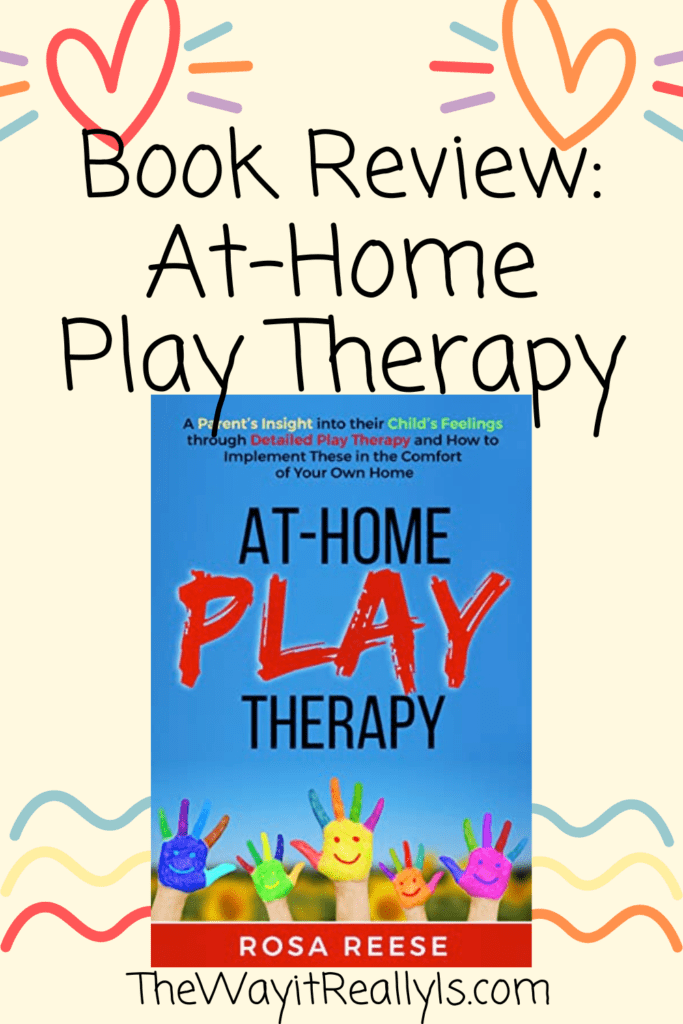
As a mom of identical twins and a son two years older, I have gained invaluable experience in the realm, and chaos, of parenting. With a Master's Degree and Education Specialist Degree in School Psychology, I spent years as a school psychologist, helping children navigate through their educational and emotional challenges. Now as a stay at home mom and professional blogger, I combine my areas of expertise to help you in your parenting journey.

